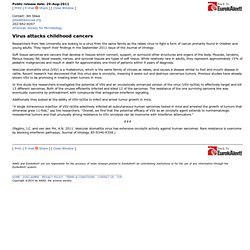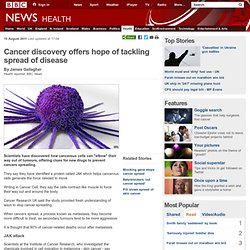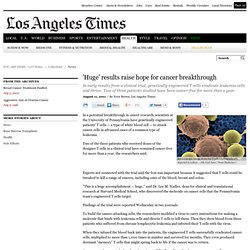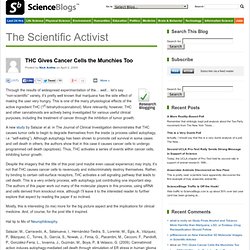

Virus attacks childhood cancers. Public release date: 29-Aug-2011 [ Print | E-mail Share ] [ Close Window ] Contact: Jim Sliwajsliwa@asmusa.org 202-942-9297American Society for Microbiology Researchers from Yale University are looking to a virus from the same family as the rabies virus to fight a form of cancer primarily found in children and young adults.

They report their findings in the September 2011 issue of the Journal of Virology. Soft tissue sarcomas are cancers that develop in tissues which connect, support, or surround other structures and organs of the body. Vesicular stomatitis virus (VSV) is a rhabdovirus, which is the same family of viruses as rabies, and causes a disease similar to foot and mouth disease in cattle. Harmless soil-dwelling bacteria successfully kill cancer. Cancer discovery offers hope of tackling spread of disease. 15 August 2011Last updated at 17:04 By James Gallagher Health reporter, BBC News Scientists have discovered how cancerous cells can "elbow" their way out of tumours, offering clues for new drugs to prevent cancers spreading.

They say they have identified a protein called JAK which helps cancerous cells generate the force needed to move. Clinical trial raises hope for cancer treatment - latimes.com. A microscopic image shows two T cells binding to beads, depicted in yellow,… (Dr.

Carl June / Penn Medicine ) In a potential breakthrough in cancer research, scientists at the University of Pennsylvania have genetically engineered patients' T cells — a type of white blood cell — to attack cancer cells in advanced cases of a common type of leukemia. Two of the three patients who received doses of the designer T cells in a clinical trial have remained cancer-free for more than a year, the researchers said. Experts not connected with the trial said the feat was important because it suggested that T cells could be tweaked to kill a range of cancers, including ones of the blood, breast and colon. Exercise a 'wonder drug' that can stop cancer coming back - Scotsman.com News. Exercise is a "wonder drug" for cancer survivors and may even prevent the disease coming back, according to a new report.

Macmillan Cancer Support said physical activity should be "prescribed" by doctors after "hard evidence" showed it can significantly help recovery and prevent other long-term illnesses. Rather than patients being told to "rest up" as in the past, doctors must encourage people to get moving as soon as they feel able. A review of more than 60 studies for the charity found people undergoing treatment for cancer - as well as survivors - could benefit from exercise. During treatment, being active does not worsen patients' fatigue and has positive effects on mood and wellbeing, the study said. Once treatment has finished, exercise can reduce the impact of side effects, such as swelling, anxiety, depression, fatigue, impaired mobility and changes to weight. Biologist says cancers might actually be newly-evolved species inside your body. Low dose naltrexone LDN: Harnessing the body’s own chemistry to treat human ovarian cancer. Formaldehyde Is Added to List of Carcinogens + (Aspartame Lupus claim)
The government issued warnings on Friday about two materials used daily by millions of Americans, saying that one causes cancer and the other might.Government scientists listed formaldehyde as a carcinogen, and said it is found in worrisome quantities in plywood, particle board, mortuaries and hair salons.

They also said that styrene, which is used in boats, bathtubs and in disposable foam plastic cups and plates, may cause cancer but is generally found in such low levels in consumer products that risks are low.Frequent and intense exposures in manufacturing plants are far more worrisome than the intermittent contact that most consumers have, but government scientists said that consumers should still avoid contact with formaldehyde and styrene along with six other chemicals that were added Friday to the government’s official Report on Carcinogens.
Cancer cells accelerate aging and inflammation in the body to drive tumor growth. THC Gives Cancer Cells the Munchies Too : The Scientific Activist. Through the results of widespread experimentation of the… well… let’s say “non-scientific” variety, it’s pretty well known that marijuana has the side effect of making the user very hungry.

This is one of the many physiological effects of the active ingredient THC (? 9-tetrahydrocannabinol). More relevantly, however, THC and other cannabinoids are actively being investigated for various useful clinical purposes, including the treatment of cancer through the inhibition of tumor growth. A new study by Salazar et al. in The Journal of Clinical Investigation demonstrates that THC causes tumor cells to begin to degrade themselves from the inside (a process called autophagy, i.e. “self-eating”). Despite the imagery that the title of this post (and maybe even casual experience) may imply, it’s not that THC causes cancer cells to ravenously and indiscriminately destroy themselves. Mostly, this is interesting (to me) more for the big picture aspect and the implications for clinical medicine. New drug shrinks cancer in animals, U-M study shows. Public release date: 6-Apr-2011 [ Print | E-mail Share ] [ Close Window ] Contact: Nicole Fawcettnfawcett@umich.edu 734-764-2220University of Michigan Health System.

'Good cholesterol' nanoparticles seek and destroy cancer cells. Cancer turns out to be a p53 protein aggregation disease. Single-cell blood test offers hope for future cancer patients.